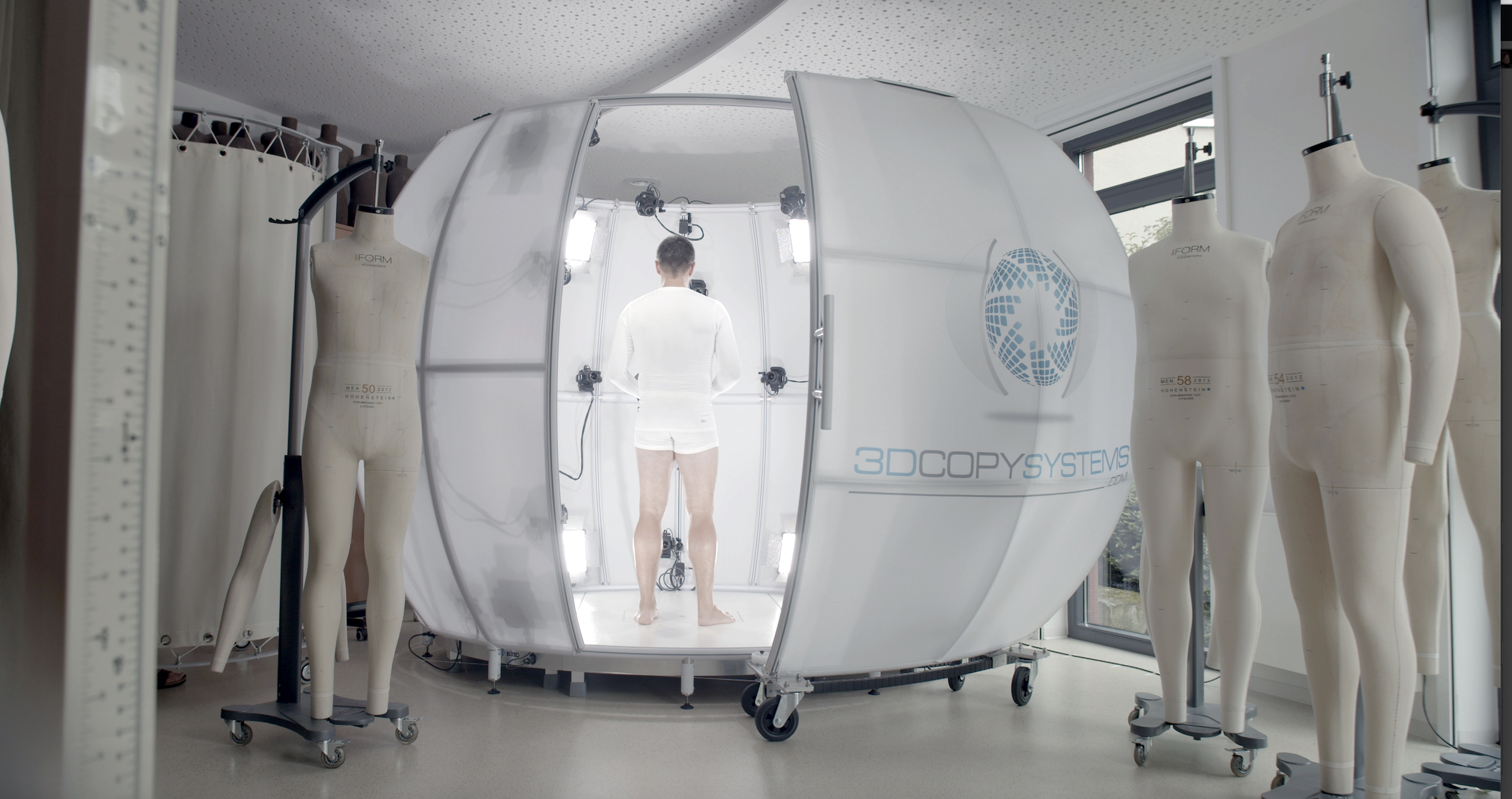Nestled between vineyards in Bönnigheim, a town with a population of around 8,000 in Baden-Württemberg, Germany, stands a castle that serves as the headquarters of Hohenstein Group, a family-owned business which for more than 70 years has specialized in clothing sizing, textile standards and quality assurance for the apparel sector.
But it would be a mistake to think that this Mittelstand company is stuck in the past. Behind the turreted castle is a campus that contains, among other things, a lab where experts on textiles have been working on digitizing the sector for years, developing digital fitting innovations such as 3D and 4D body scans (see the photo). Now, Hohenstein is augmenting its in-house expertise with artificial intelligence and computer vision technology developed by Munich-based startup.Sizekick to recommend the right clothing size in fashion e-commerce.
Hohenstein has invested €1.3 million in the startup. Its collaboration with Sizekick provides some valuable insights on what it takes to become a future-ready small and medium-sized business.
“Young German entrepreneurs need the ability to engage with local companies who will deploy their innovations and become partners and co-developers of their ventures as easily as it happens in Silicon Valley,” says Antoine Leboyer, Managing Director, Software and Artificial Intelligence at the Technical University of Munich’s Venture Labs, which served as an advisor to Sizekick on the deal. “Every company in Germany should take note of the strong relationship established between the Hohenstein Group and Sizekick and follow their example by partnering with relevant startups to benefit from their speed and innovation by combining it with their own expertise.
Sizing Up The Situation
Hohenstein started life as an education and research center for textile technology but when the sector moved out of Europe to Asia it had to reinvent itself, says CEO Stefan Droste. Today Hohenstein is a modern service provider which employs more than 1,000 people globally, offering a range of accredited testing and inspection services that provide brands with certification that their products are pollutant-free, environmentally-friendly and produced under socially acceptable working conditions. It has also honed its expertise, using modern technology, to help apparel brands and retailers correctly size their clothing. Droste, who earned a PhD in chemistry and is currently earning a degree in organizational management, was hired by the family to help the company to continue to adapt to market needs.
Hohenstein has decades of experience in creating sizing charts for garments that fit target groups but the rise of e-commerce has introduced new challenges, says Droste. When people try on clothes in-store they buy the ones that fit and mentally make a note of what to get next time. People buying online need to guess and often order several sizes to see what works best and send back the ones that don’t fit. The economics of handling the free shipping of huge numbers of returns is not working for e-commerce providers.
That is where Sizekick comes in. Founders David Oldeen and Jake Lydon previously worked together at Presize. After that company was sold to Meta (the company formerly known as Facebook) in April of 2022, the two decided to launch their own B2B startup. “The fashion industry is struggling with a huge number of size-related returns in e-commerce,” says Oldeen. “At Sizekick we help brands and retailers solve this problem by reducing the size uncertainty of online shoppers. We use AI and computer vision technology to determine the accurate body measurements of the shoppers with the help of a smartphone only, match it with the product and provide an individual size recommendation for the item in the online shop. This way guaranteed returns because of ‘size sampling’ (ordering several sizes of one article) can be prevented and less badly fitting clothes are delivered to online customers.”
Sizekick’s technology was developed from scratch, says Oldeen. “As a completely new AI solution, our strategic partnership with Hohenstein enables us to meet the market’s high demand right from the start,” he says. “Thanks to Hohenstein, our artificial intelligence is already learning from one of the world’s largest and highest-quality databases of 3D body scans. The gigantic advantage this provides our AI cannot be overstated.”
The Hohenstein family agreed to invest in Sizekick “because they understand the market very well and felt they could judge the likelihood of a service being developed that would be successful on the market,” says Droste.
Investing in a startup made sense because Hohenstein did not have the software development expertise to build such as solution themselves and was unlikely to be able to hire the right IT talents, given its rural location, he says.
“Sizing at a distance is difficult to solve,” says Droste. “We have the domain knowledge. It is part of our heritage: we know what bodies look like and how garments behave. Sizekick’s approach reduces uncertainty. It is an add-on to the services we are already offering, but doesn’t change our approach. The information captured by their smartphone app can be compared to the information in the Hohenstein databases.”
From First Contact To Contract
Oldeen got to know Hohenstein’s Chief Marketing Officer while working at Presize and reached out to him after launching Sizekick. “He immediately saw the unique opportunity for a partnership of Hohenstein with the new startup,” he says. “We were able to move from first contact to contract between April and October.”
TUM Venture Labs, a joint initiative of Technical University of Munich and UnternehmerTUM that leverages the strong network of SMEs at Europes largest innovation center (such as family businesses via FamilienUnternehmerTUM) as well as offering mentoring from seasoned business executives like Leboyer, advised Sizekick during the investment negotiations.
Hohenstein previously invested in a startup which did well financially but did not help the family-run business with its strategic objectives. This time around the company was determined not to make the same mistake, says Droste.
“We are not interested in hockey stick business plans and quick exits,” says Droste. “I told David ‘if you are seeking investment aimed at maximizing value quickly we are out’. The investment horizon of family businesses is strategic rather than short-term.”
Negotiations were not easy, says Droste. “We both had red lines on how far we could go. It was not a walk in the park for either of us. Both sides had to make compromises but are both driven by the belief in the joint market opportunities.”
Challenges included a clash of cultures. For example, Mittelstand companies are not used to granting shares, but Oldeen successfully argued that he needed to be able to grant them to win the war for talent with the likes of Google.
Startups and traditional companies also work on different time scales and “the two different speeds crash into each other,” says Droste.
To get the most value out of the partnership from the start, both companies invested in knowledge transfer between the teams, from deep learning engineers to textile experts and vice versa. Now they regularly meet to brainstorm and participate in onsite workshops. “The Hohenstein team enjoys working with them and appreciates the new perspective on things,” he says. “It is not about working with a startup but rather with a team of professionals we want as partners. It is clear we can be beneficial to each other.”
For Sizekick “it was never just about the money, we see many more synergies in the future and together we can provide a lot of value to the fashion brands and retailers that Hohenstein works with,” says Oldeen.
Finding The Right Fit
Droste’s advice to other family-run businesses that are considering working with startups? “Be aware of different corporate cultures and realize that autonomy is part of a startup’s strength but at the same time don’t be afraid to say: ‘This is my company culture.’ Manage your expectations and be aware that there are likely to be hiccups down the road. Make sure there is strong accountability and responsibility and spell out the specifics: bonus schemes, potential upsides, and stock options. These things need to be crystal clear.” Most importantly, seek a reliable and trustworthy partner, says Droste. Startups can fit that bill, he says, but he cautions, “first make sure they are the right fit.”
This article is content that would normally only be available to subscribers. Sign up for a four-week free trial to see what you have been missing







